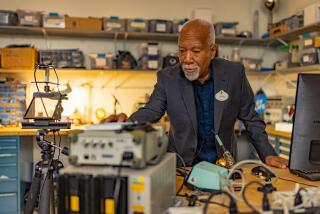THE FUTURE : Smart-Tech Homes on Way
- Share via
The Home of the Future was, sadly, to become the Home of the Past on a pleasant spring day in 1967 when a wrecking crew prepared to level one of Disneyland’s landmark exhibits.
The Monsanto Chemical Co.’s vision of the future, an all-plastic residential showcase filled with high-tech gadgetry, was about to pass into history to make way for a new and improved Tomorrowland.
As a small group of park employees looked on, a massive iron wrecking ball began its assault on one of the home’s four floating wings. What happened next can only be described as a testament to the durability of plastic.
“That wrecking ball just sort of bounced off the house like a giant rubber ball,” recalled witness Ray Schwartz.
Van France, founder of Disneyland’s employee training program and recipient of a rare park honor--a commemorative window on Main Street--said the Home of the Future put up a stubborn fight. “I was amazed that a bulldozer could knock down a regular house in a couple of hours, while this seemed to take days.”
It did take about six days, according to Schwartz.
“Everyone thought it would be a quick job,” said the former Disneyland maintenance supervisor. “Maybe a day or so at most. But it took much longer than anticipated. That Fiberglas was a tough bugger to break.”
But persistence and brute force finally prevailed. The gleaming white shell was smashed and the last plastic shards of Fiberglas, Lustrex and Ultron trucked away.
But the memory of the future lingered.
It was a future of hits, near misses and the occasional wild shot, much like the radical shape of the home itself. While the traditional home was basically a wood-framed box set in the ground, this floating cross of suspended plastic seemed to hover, seemingly ready to fly off into the 21st Century.
When the Home of the Future opened in June, 1957, it was presented as “the forerunner of the dwelling of the typical American family of four 10 years from now.”
Instead, at the end of those 10 years, the Home of the Future itself was a pile of rubble. And, to this day, houses are still built as wood-framed boxes set in the ground.
But the plastic furnishings of the home, the plastic chairs and countertops, together with the acrylic carpets and upholstery, foretold a future that has evolved with a vengeance. In the 1950s, plastics were the wonder materials of in-home living. Today they are a fundamental.
Other predictions advanced by Monsanto’s team of futurists were to find their way into the American home: Microwave cooking, telephones with pre-set and push-button dialing, speaker phones and central climate control.
The home had a built-in entertainment center complete with stereo, tape recorder and something called an “observascope,” actually a giant color television that doubled as a movie screen (a forerunner of the age of video).
And then there were the misses: stoves and appliances that disappeared into kitchen walls and countertops at a push of a button, atomic food preservation (whatever that was), ultrasonic dish-washing and a picture telephone.
But in the 1950s, Monsanto’s plastic home was a bold new world, albeit one with synthetic underpinnings. It was also a practical advertisement for the chemical company’s products.
For many of the 18 million or so people who toured its plastic and electronic wonders during its Disneyland run, it became something of an old friend. Which is a lousy thing for a Home of the Future to become.
“There were a lot of us who hated to see it go,” Schwartz said. “It was all fancied up for the future. It’s just that the future, in a lot of ways, had caught up to it.”
Which is what the future does, and why predicting the future home will always be a growth industry.
“The trouble with our times is that the future is not what it used to be.”--Paul Valery, French poet
Indeed it is not. Certainly not in the home.
Futurists once routinely predicted that homes would one day float in the air, or perhaps nestle underground, where they would serve as fully automated, high-tech human habitats.
It was simpler to predict the future home in simpler times. All the dreamy in-home wizardry was just a technological stone’s throw from the imagination.
The future home was going to be full of gadgets and was going to adapt itself into new and stunning shapes.
Gregory Benford, an award-winning science-fiction writer who lives in Laguna Beach and is a professor of physics at UC Irvine, visited the Disneyland dwelling in 1963. “It was interesting, but I didn’t think then that houses (of the future) would look like French Impressionist paintings, and I still don’t.”
Benford predicts that the home of the future 20 or 30 years from now will still look like today’s tract dwellings. “But they’ll be smarter,” he said.
As Benford foresees it, an aging population will mean an in-home future built on rollers and open spaces. “That way furniture and appliances can be moved more easily as people grow older.”
Beds will be adjustable, like those in a hospital, to meet the physical needs of the occupant. Also expected are light-colored or white roofs that will reflect sunlight and lower cooling costs, and banks of on-site residential solar cells for generating electricity from sunlight.
Benford admits that his practical future lacks the zing of past predictions that foretold of levitating lawn mowers and atomic garbage disposals. “The approach is more smart-tech rather than high-tech,” he explained.
“We can build houses full of gizmos, but when the gadgetry begins to fail, that’s when the real costs of a high-tech future begin to come around,” he said.
One item not to be found in the future home, according to Benford, is “a helipad on the roof.” Futurists used to predict that people would someday commute to work in their own personal helicopters. “Anyone who knows how difficult it is to fly a helicopter would recognize this sort of thinking as a ticket to enormous disaster,” Benford said.
And still, like the call of the wild, the echo of a more exotic future home tugs at Benford’s powers of prophesy.
He confesses that he once wrote an article for Smithsonian Magazine that predicted the completely computerized and automated house. “You’d be able to dial your home’s central computer before you left work and command it to open a window or turn on the heat, start your casserole cooking and let the cat out of the cat door.”
Alas, both homeowner and family cat have yet to see the advent of the fully automated house. Benford, though, remains good-naturedly stubborn about his future-gazing.
“I predicted (the computerized home) in 1969, and I’m still predicting it,” he said.
Behnam Bavarian, a futurist and colleague of Benford’s at UC Irvine, agrees with Benford’s assessment that the home of the future will look a lot like the home of today, with one major departure. The assistant professor of electrical and computer engineering warns that depletion of the earth’s ozone layer could have a major impact on future dwellings.
“It could be very bad if we have a disaster with the ozone layer,” he said. “If that happens, we may have to live in houses or apartments that are shielded from ultraviolet radiation” that is now largely filtered by the ozone cover.
Computerized window shutters would close automatically to shut out ultraviolet rays during peak periods. Or, on a more drastic scale, huge shelterlike apartment complexes would be built to shield large groups of residents. The home of tomorrow could become the fortress of the future.
So-called “smart” homes that protect us from pollution and each other, that conserve energy and help control waste, may be forced upon us by the realities of 21st-Century living, Bavarian says.
Computers and sensors would be the sentries on guard against a potentially hostile environment.
Scratch a futurist, however, and you will likely find an optimist lurking beneath the surface. Bavarian believes that, barring any environmental disaster such as an ozone wipeout, these are all problems that “can be handled very well through applied technology.”
Although Bavarian never visited the Monsanto house at Disneyland, he predicts that at least one of the home’s innovations--ultrasonic dish-washing--will be common within the next 10 years, as will clothes washers and dryers that work by ultra-sound.
“It’s not a big deal to design ultra-sound devices that will vibrate clothes to get the dirt out,” he said. “Or machines that will clean dishes. Ultrasound is a very safe technology.”
Bavarian says that society will be pushed to use ultrasound to save precious water resources and to cut down on chemical pollution due to the use of detergents.
Like Benford, however, he doubts that many homes in the coming decade will have picture phones. “Picture phones need fiber optics to transmit large amounts of information,” he explained. “Not just in commercial networks, but in the home itself. Every home will need its own fiber optic system installed. It will cost a lot of money to do that.”
Besides, Bavarian says, “probably most people will not want to have to look at everybody who is calling them, anyway.”
For those who fear that the future is going to be starved for gadgets, Bavarian suggests that there is a lot more to the home of tomorrow than picture phones. Within the next 10 years, he predicts, we may be cooking with lasers, playing tennis with our television sets, and carrying on limited conversations with our household appliances.
None of that is as far-fetched as it seems, he says. “‘We could combine a laser with a microwave oven, for example. The laser would make food crispy on the outside while the microwave cooked it from the inside.”
On the other hand, trading tennis volleys with the telly would be a matter of using on-screen simulation, sensors and actual physical movement to “play” a computer-driven match.
And conversing with appliances can be accomplished through the use of sensors and speech processors embedded throughout the house, Bavarian says. “You can talk with the microwave or dishwasher and tell them what you want them to do. They will take a verbal command and convert it to action.”
He admits that such technology is not cost-effective now, but “it can be in 10 years.”
He also points out that such voice-activated devices could be tuned specifically to you so that no one else could use them.
Bavarian carries the concept of talking appliances a step further. Actually, it was more like one small step for a futurist, one giant leap for robotics.
For Bavarian foresees the day in the next 25 years when “intelligent” robots will perform most chores around the house.
“Robots have been predicted for the home for a long time,” he said. “But there has been great difficulty getting them to perform flexible, multipurpose tasks.”
Which is why Bavarian, whose research interests lie in this area, believes that some form of artificial intelligence, coupled with advanced sensors and new dynamics of robotic movement, must first be developed before robots can take their rightful place in the average home of 2015.
He predicts that computers based on artificial neural networks that mimic those found in the human brain will allow these future generation robots to make decisions based on their memory of past experiences. In other words, they will be able to learn through trial and error.
“A robot may make the same mistake two or three or four times, but eventually it will learn the correct way of doing something,” he said. “The point is, the robot will learn on its own. It will automatically improve itself every day. It will be capable of some sort of reasoning.”
In addition to all this self-improvement, the robot will keep a close eye on its owner’s wants and needs.
“The robot will learn your behavior, your characteristics,” he said. “It’ll have sensor technology that will duplicate vision and speech. It will be able to look at your face and recognize that it’s you.”
The robot of the future will be sort of a movable, benevolent Big Brother, according to Bavarian. “It just watches you. It accommodates you. The things that you like to do it provides for you.”
Still, couldn’t such a smart robot educate itself enough that it might start to get ideas of its own? Could the electronic tin man of the future suddenly find one day that he has a heart? And a desire for a life of his own? Or, at least, Sundays off?
Bavarian shook his head. “The bottom line is that (robots) are machines,” he explained. “I don’t think that would be possible.”
But a seed of doubt had been sown.
“Well,” he said, after a pause. “Who knows what the future holds?”
More to Read
Inside the business of entertainment
The Wide Shot brings you news, analysis and insights on everything from streaming wars to production — and what it all means for the future.
You may occasionally receive promotional content from the Los Angeles Times.










